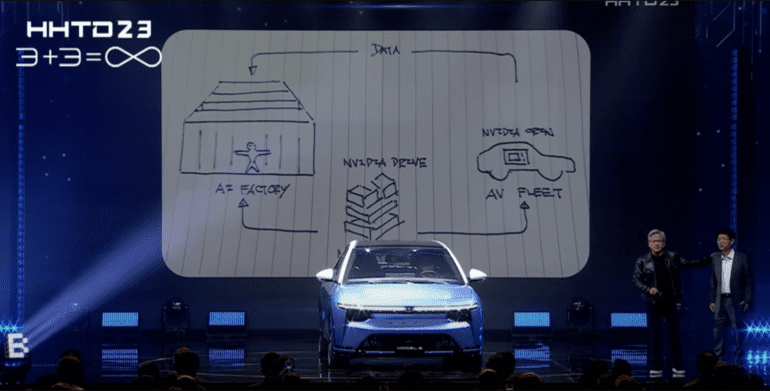TL;DR:
- Nvidia is strengthening its presence in the autonomous driving sector.
- The company is recruiting talent in China for various roles in autonomous driving.
- Xinzhou Wu, a key figure in China’s smart driving space, leads the team.
- Wu joined Nvidia from Xpeng, a prominent Chinese electric vehicle company.
- Nvidia’s powerful graphics cards, like the Thor chips, give it an edge in the self-driving market.
- China’s competitive auto industry makes it a crucial hub for autonomous driving talent.
- Wu emphasizes China’s role in driving Nvidia’s smart driving commercialization.
- Despite export controls, Nvidia’s automotive products remain unaffected.
- Wu’s role at Nvidia involves AI system development for automation and autonomous vehicles.
- There are hints of a potential partnership between Xpeng and Nvidia in the semiconductor field.
Main AI News:
Nvidia, a semiconductor giant renowned for its groundbreaking graphic processing units capable of executing millions of computations simultaneously, is intensifying its commitment to the autonomous vehicle industry. In a strategic maneuver, the company is harnessing the vast pool of talent in China to bolster its autonomous driving endeavors.
The firm has embarked on a recruitment drive, aiming to fill two dozen pivotal roles within its autonomous driving team, strategically dispersed across key Chinese cities, including Beijing, Shanghai, and Shenzhen. This recruitment initiative spans a spectrum of domains, encompassing software development, end-to-end platform engineering, system integration, mapping expertise, and product specialization. Leading this formidable team is Xinzhou Wu, a luminary recognized for his pivotal role in bringing smart driving features to the mainstream automotive market in China over recent years.
Nvidia’s acquisition of Xinzhou Wu, the former head of autonomous vehicles at Xpeng, a prominent Chinese electric vehicle manufacturer often likened to Tesla for its unwavering commitment to smart driving, underscores the company’s dedication to driving innovation in the autonomous driving space. Wu now serves as Nvidia’s Head of Automotive and is a member of the executive staff, reporting directly to Jensen Huang, the founder, and CEO of the chip giant.
Nvidia’s dominance in the self-driving realm is attributed to its formidable graphics processing units, particularly exemplified by its groundbreaking Thor automotive-grade chips, boasting a staggering 2,000 teraflops of performance unveiled in September last year.
The significance of China as a pivotal hub for Nvidia’s autonomous vehicle aspirations cannot be overstated. Fierce competition within China’s automotive sector has spurred electric vehicle manufacturers to invest significantly in autonomous driving technologies, creating a vast talent pool with invaluable experience in transitioning autonomous driving concepts from research and development to mass production.
Xinzhou Wu, who serves as the head of autonomous vehicles at Nvidia and personally oversees the China autonomous driving team, acknowledges the critical role China plays in potentially driving Nvidia’s commercial success in smart driving. In his statement included in the job posting, Wu expresses optimism, stating, “Let’s hope that the Chinese autonomous driving team can become a core force in driving the commercialization of Nvidia’s autonomous driving products, tapping the country’s talent and experience to create autonomous driving solutions for the global market.”
Navigating the complex geopolitical landscape, Nvidia maintains a delicate relationship with China. Under U.S. export controls, the chip giant is currently restricted from exporting its most powerful AI GPUs to China, one of its largest markets. However, the company’s automotive product portfolio remains unaffected by these restrictions.
Under the guidance of Xinzhou Wu, Nvidia’s autonomous driving team undertakes a multifaceted role, encompassing the design, development, and deployment of cutting-edge AI systems tailored for automation and autonomous vehicles. The team’s responsibilities encompass a wide spectrum, including AI training, real-time data processing within vehicles, catering to diverse applications such as robotaxis, commercial fleets, and passenger vehicles.
Xinzhou Wu’s career trajectory has received the blessings of his former employer, Xpeng’s founder and CEO, He Xiaopeng. In a Weibo post announcing Wu’s departure, He expressed pride in Wu’s elevation to a “top-level management role” at a “globally renowned company,” which was later revealed to be Nvidia. Social media interactions between He and Wu have also hinted at a potential partnership between Xpeng and Nvidia in the semiconductor domain.
In a photo shared by Wu on the eve of his commencement at Nvidia, he was flanked by both Huang and He, indicating a close collaboration between the two companies. Wu humorously remarked, “Tomorrow is my first day at Nvidia, and I appreciate Xiaopeng for personally escorting me here. According to Old Huang [Jensen Huang], I will still be working for Xiaopeng in the future, just without him having to pay my salary.”
As Nvidia strategically taps into the formidable talent pool in China’s autonomous driving sector, the industry watches with anticipation as this semiconductor powerhouse advances its mission to reshape the future of smart and autonomous vehicles on a global scale.
Conclusion:
Nvidia’s strategic move to tap into Chinese talent underscores its commitment to the global autonomous driving market. Leveraging its expertise and recruiting top talent in China positions Nvidia for significant advancements in smart and autonomous vehicle technology, potentially leading to groundbreaking innovations in the industry.

